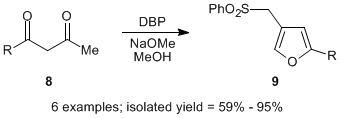
ACS PRF | ACS
All e-Annual Reports

42382-B1
Sulfone-based Methodology for the Construction of Biologically Relevant Furans
Progress has been made in establishing the generality of a novel furan synthesis using the sulfone reagent 2,3-dibromo-1-phenylsulfonyl-1-propene (DBP) in the presence of 1,3-diketones (e.g., 1) and methanolic sodium methoxide.

Specifically, one goal was to optimize the newly elaborated phenylsulfonylmethyl furans (e.g., 2) to the corresponding furoic acid derivatives. Toward this end, benzyl phenyl sulfone (3) was used as a model system. In the course of these studies, a moderate counterion effect was observed, with potassium hexamethyldisilazide giving the best results.

When the optimized conditions were applied to the sulfonyl furan 2, the corresponding 5-methylfuran-3-carboxylic acid (5) was isolated in 95% yield. Encouraged by these results, we surveyed a variety of alkyl phenyl sulfones, and found that the aerobic oxidative desulfonylation was tolerant to a wide variety of substrates, providing carboxylic acids (e.g., 7) in good to excellent isolated yields. Since the starting substrates can be accessed by the alkylation of phenyl methyl sulfone, this represents a new protocol for the synthesis of carboxylic acids from alkyl halides.


The second area of significant progress in generalizing the sulfonyl-based furan synthesis was with respect to the alkyl group in the 2-position. Here we built upon the observation that when unsymmetrical 1,3-diketones were employed, and a methyl group was attached to one terminus, the acetyl moiety was preferentially cleaved along the mechanistic pathway, leaving the remaining substituent to occupy the 2-position of the furan. This differentiation was remarkably efficient: in the most demanding example (8, R = Me), the selectivity was 5:1; however, in all other cases, the selectivity was > 11:1 and in some instances there was exclusive loss of the acetyl group.

Inasmuch as there are some general methods to access the necessary methyl 1,3-diketones, this result opens the door to expanding the new furan synthesis to a variety of targets of biological interest.